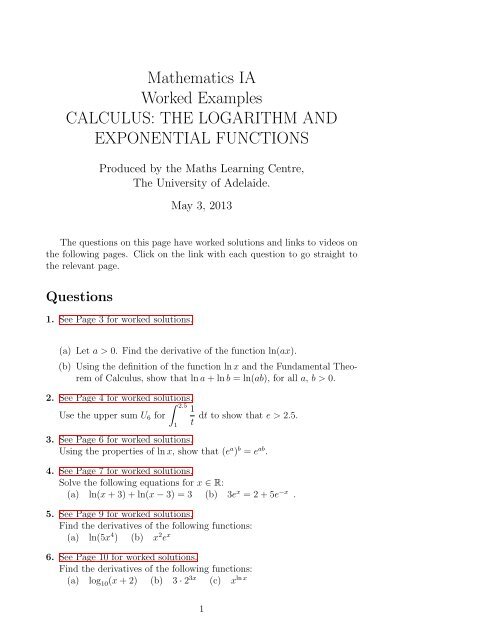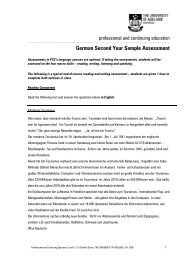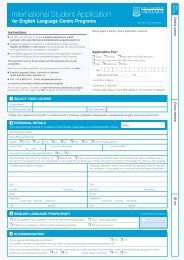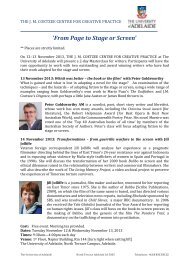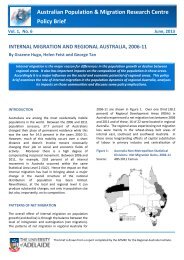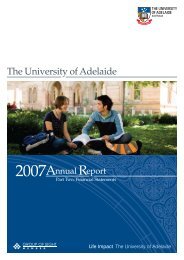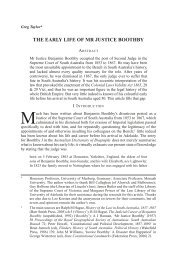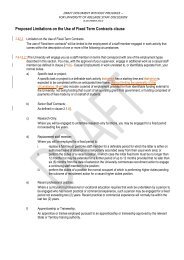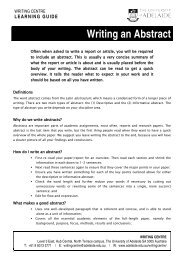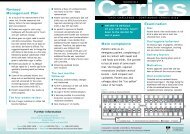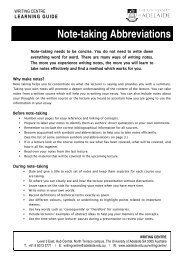Worked examples for the Maths IA topic 'Logarithms and Exponentials'
Worked examples for the Maths IA topic 'Logarithms and Exponentials'
Worked examples for the Maths IA topic 'Logarithms and Exponentials'
You also want an ePaper? Increase the reach of your titles
YUMPU automatically turns print PDFs into web optimized ePapers that Google loves.
Ma<strong>the</strong>matics <strong>IA</strong><br />
<strong>Worked</strong> Examples<br />
CALCULUS: THE LOGARITHM AND<br />
EXPONENT<strong>IA</strong>L FUNCTIONS<br />
Produced by <strong>the</strong> <strong>Maths</strong> Learning Centre,<br />
The University of Adelaide.<br />
May 3, 2013<br />
The questions on this page have worked solutions <strong>and</strong> links to videos on<br />
<strong>the</strong> following pages. Click on <strong>the</strong> link with each question to go straight to<br />
<strong>the</strong> relevant page.<br />
Questions<br />
1. See Page 3 <strong>for</strong> worked solutions.<br />
(a) Let a > 0. Find <strong>the</strong> derivative of <strong>the</strong> function ln(ax).<br />
(b) Using <strong>the</strong> definition of <strong>the</strong> function ln x <strong>and</strong> <strong>the</strong> Fundamental Theorem<br />
of Calculus, show that ln a + ln b = ln(ab), <strong>for</strong> all a, b > 0.<br />
2. See Page 4 <strong>for</strong> worked solutions.<br />
2.5<br />
1<br />
Use <strong>the</strong> upper sum U6 <strong>for</strong> dt to show that e > 2.5.<br />
t<br />
3. See Page 6 <strong>for</strong> worked solutions.<br />
Using <strong>the</strong> properties of ln x, show that (e a ) b = e ab .<br />
4. See Page 7 <strong>for</strong> worked solutions.<br />
Solve <strong>the</strong> following equations <strong>for</strong> x ∈ R:<br />
(a) ln(x + 3) + ln(x − 3) = 3 (b) 3e x = 2 + 5e −x .<br />
5. See Page 9 <strong>for</strong> worked solutions.<br />
Find <strong>the</strong> derivatives of <strong>the</strong> following functions:<br />
(a) ln(5x 4 ) (b) x 2 e x<br />
6. See Page 10 <strong>for</strong> worked solutions.<br />
Find <strong>the</strong> derivatives of <strong>the</strong> following functions:<br />
(a) log10(x + 2) (b) 3 · 23x ln x (c) x<br />
1<br />
1
7. See Page 12 <strong>for</strong> worked solutions.<br />
Use <strong>the</strong> definitions of sinh x <strong>and</strong> cosh x to show that<br />
cosh(2x) − 1 .<br />
sinh 2 x = 1<br />
2<br />
8. See Page 13 <strong>for</strong> worked solutions.<br />
Let arctanh x be <strong>the</strong> inverse function of tanh x. Write down <strong>the</strong> domain<br />
<strong>and</strong> range of arctanh x <strong>and</strong> find a <strong>for</strong>mula <strong>for</strong> arctanh x.<br />
9. See Page 15 <strong>for</strong> worked solutions.<br />
Find <strong>the</strong> derivatives of <strong>the</strong> following functions:<br />
(a) sinh(x 2 ) (b) tanh 3 (x) (c) cosh x cos x<br />
2
1. Click here to go to question list.<br />
(a) Let a > 0. Find <strong>the</strong> derivative of <strong>the</strong> function ln(ax).<br />
(b) Using <strong>the</strong> definition of <strong>the</strong> function ln x <strong>and</strong> <strong>the</strong> Fundamental Theorem<br />
of Calculus, show that ln a + ln b = ln(ab), <strong>for</strong> all a, b > 0.<br />
Link to video on YouTube<br />
3
2. Click here to go to question<br />
<br />
list.<br />
2.5<br />
1<br />
Use <strong>the</strong> upper sum U6 <strong>for</strong> dt to show that e > 2.5.<br />
1 t<br />
Link to video on YouTube<br />
4
3. Click here to go to question list.<br />
Using <strong>the</strong> properties of ln x, show that (e a ) b = e ab .<br />
Link to video on YouTube<br />
6
4. Click here to go to question list.<br />
Solve <strong>the</strong> following equations <strong>for</strong> x ∈ R:<br />
(a) ln(x + 3) + ln(x − 3) = 3 (b) 3e x = 2 + 5e −x .<br />
Link to video on YouTube<br />
7
5. Click here to go to question list.<br />
Find <strong>the</strong> derivatives of <strong>the</strong> following functions:<br />
(a) ln(5x 4 ) (b) x 2 e x<br />
Link to video on YouTube<br />
9
6. Click here to go to question list.<br />
Find <strong>the</strong> derivatives of <strong>the</strong> following functions:<br />
(a) log10(x + 2) (b) 3 · 23x ln x (c) x<br />
Link to video on YouTube<br />
10
7. Click here to go to question list.<br />
Use <strong>the</strong> definitions of sinh x <strong>and</strong> cosh x to show that<br />
cosh(2x) − 1 .<br />
sinh 2 x = 1<br />
2<br />
Link to video on YouTube<br />
12
8. Click here to go to question list.<br />
Let arctanh x be <strong>the</strong> inverse function of tanh x. Write down <strong>the</strong> domain<br />
<strong>and</strong> range of arctanh x <strong>and</strong> find a <strong>for</strong>mula <strong>for</strong> arctanh x.<br />
Link to video on YouTube<br />
13
9. Click here to go to question list.<br />
Find <strong>the</strong> derivatives of <strong>the</strong> following functions:<br />
(a) sinh(x 2 ) (b) tanh 3 (x) (c) cosh x cos x<br />
Link to video on YouTube<br />
15


